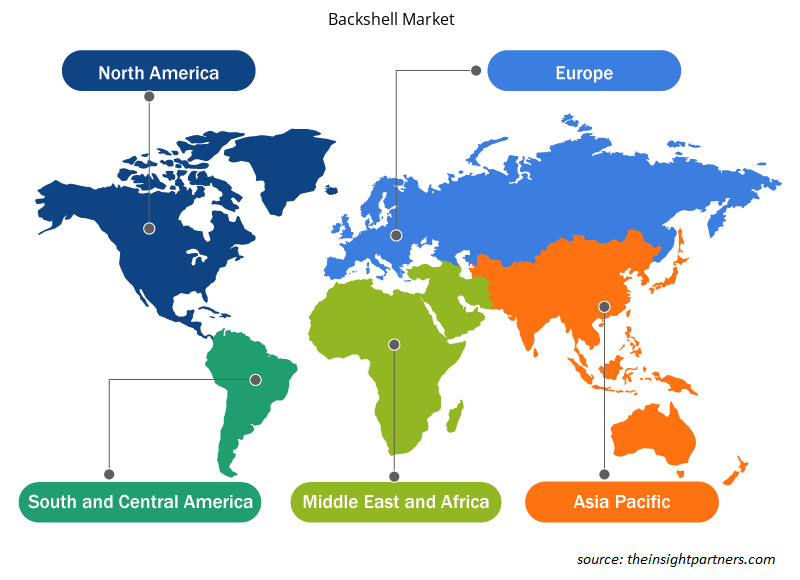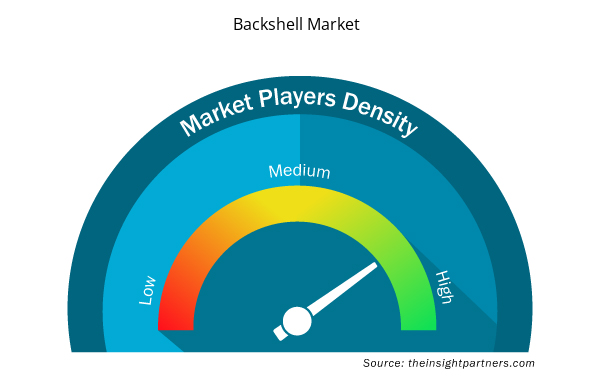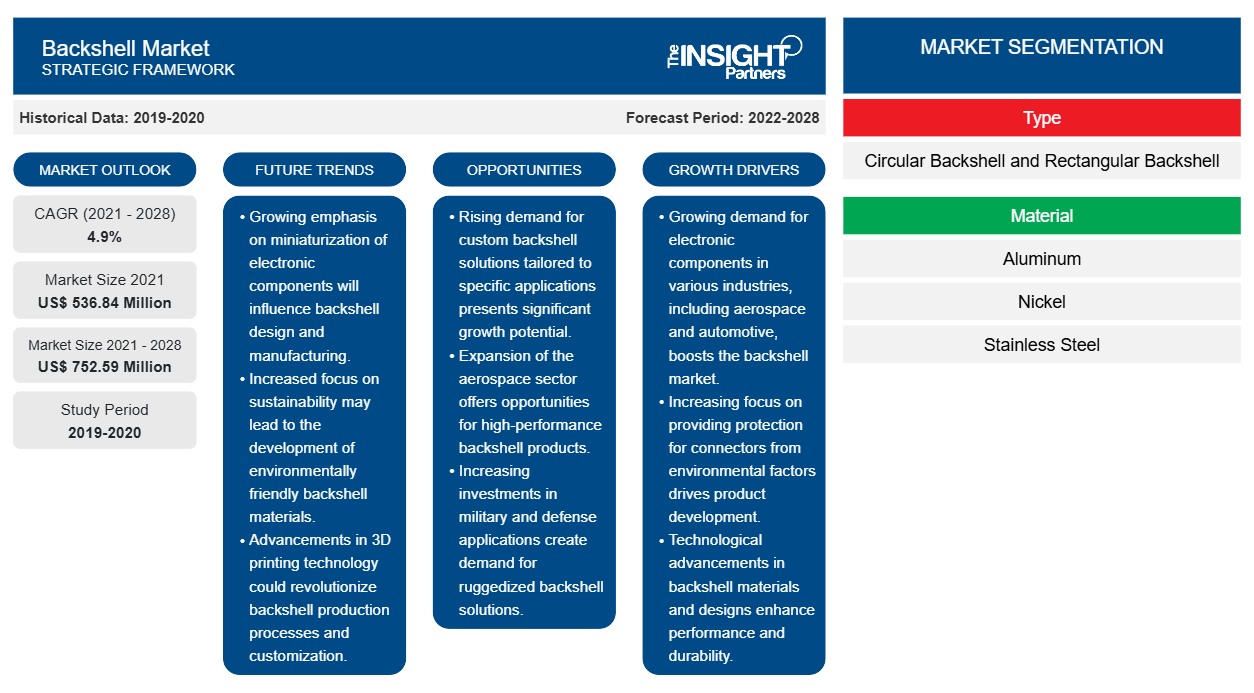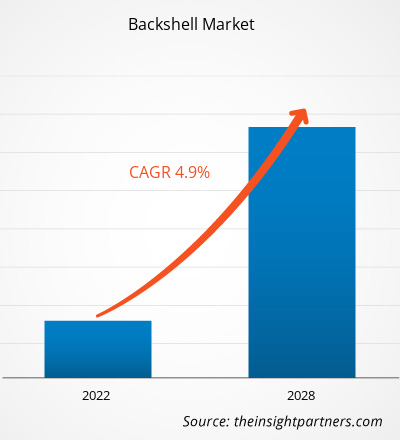El mercado de carcasas traseras se valoró en 536,84 millones de dólares estadounidenses en 2021 y se proyecta que alcance los 752,59 millones de dólares estadounidenses en 2028; se espera que crezca a una CAGR del 4,9% entre 2021 y 2028.
La industria automotriz está experimentando un cambio de los motores de combustión interna a la electrificación debido a las crecientes preocupaciones sobre las emisiones de carbono. Los vehículos utilizados por las fuerzas armadas son en su mayoría propulsados por diésel y carecen de las capacidades de maniobra rápida de un vehículo eléctrico, como un mayor par motor, capacidad de remolque y capacidad de ascenso. Además, la firma térmica de un vehículo eléctrico (VE) no se puede detectar a gran distancia de un motor de combustión interna, lo que actúa como una gran ventaja en el campo de batalla. Actualmente, el Ejército de los EE. UU. está evaluando activamente varias opciones con los fabricantes de automóviles para desarrollar vehículos eléctricos para aplicaciones militares. Por ejemplo, en 2020, la Dirección de Desarrollo e Integración de Capacidades de Maniobra (MCDID) aprobó el estudio de vehículos tácticos y de combate con motores eléctricos. Además, en mayo de 2021, General Motors demostró un prototipo EV de su Vehículo de Escuadrón de Infantería (ISV) para aplicación militar. Además, el gobierno de EE. UU. adjudicó contratos a empresas para estudiar varias técnicas para propulsar una futura flota de 225.000 vehículos militares eléctricos. Por lo tanto, el desarrollo de vehículos eléctricos para aplicaciones militares impulsaría la adopción de conectores de grado militar, lo que posteriormente impulsaría el crecimiento del mercado de carcasas traseras en el futuro.
Impacto de la pandemia de COVID-19 en el mercado de carcasas traseras
El brote de COVID-19 ha afectado significativamente al mundo y sigue destrozando a varios países. Hasta el brote, la industria aeroespacial y de defensa estaba experimentando un crecimiento sustancial en términos de producción, a pesar de los enormes retrasos de los fabricantes de aeronaves. La industria de la aviación mundial fue testigo de un aumento significativo en el número de pasajeros y un aumento en la adquisición de aeronaves.
Desafortunadamente, el brote de COVID-19 ha diezmado la demanda de aeronaves en todo el mundo. Debido a la crisis, los fabricantes de aeronaves fueron testigos de la reducción en los volúmenes de pedidos, lo que resultó en un menor número de producciones. La disminución de los volúmenes de producción afectó negativamente a los negocios de varios fabricantes de componentes y tecnologías asociadas. Por lo tanto, los negocios de los actores del mercado de carcasas traseras se han visto gravemente afectados por la desestabilización en la producción de aeronaves. En medio del brote de COVID-19, la industria aeroespacial y de defensa fue testigo de temblores con recursos mínimos para prever el futuro. Varias unidades de producción en los EE. UU., Francia, Rusia y China se cerraron temporalmente para cumplir con las reglas gubernamentales con respecto al bloqueo y el distanciamiento físico. Los fabricantes de aeronaves fueron testigos de una reducción del 30 al 50% en la demanda de la mayoría de los modelos de aeronaves, especialmente, los modelos de aeronaves comerciales. Las restricciones a la producción y ensamblaje de aeronaves y vehículos terrestres militares han obstaculizado la demanda de carcasas traseras, lo que resultó en una menor generación de ingresos. Este factor afectó negativamente al mercado de carcasas traseras.
Personalice este informe según sus necesidades
Obtendrá personalización en cualquier informe, sin cargo, incluidas partes de este informe o análisis a nivel de país, paquete de datos de Excel, así como también grandes ofertas y descuentos para empresas emergentes y universidades.
- Obtenga las principales tendencias clave del mercado de este informe.Esta muestra GRATUITA incluirá análisis de datos, desde tendencias del mercado hasta estimaciones y pronósticos.
Perspectivas del mercado de Backshell
Uso creciente de carcasas traseras de aluminio
Las carcasas traseras de aluminio están ganando importancia en el negocio de la aviación comercial, ya que los fabricantes de aeronaves comerciales (aviación civil y general) se esfuerzan constantemente por reducir el consumo de combustible y las emisiones de CO2 y aumentar la resistencia. El uso de componentes metálicos más pesados limita a los fabricantes de equipos originales de aeronaves a la hora de alcanzar los parámetros mencionados anteriormente. Debido a esto, el uso de componentes o piezas ligeras está aumentando entre estos fabricantes. A medida que los fabricantes de equipos originales de aeronaves comerciales hacen hincapié en las carcasas traseras de aluminio para diversos conectores, la demanda de carcasas traseras de aluminio está creciendo entre los proveedores de servicios MRO. Aparte de los propietarios de la flota de aeronaves de nueva fabricación, los propietarios de la flota de aeronaves existentes también se están concentrando en modernizar sus modelos de aeronaves con carcasas traseras de aluminio ligeras y avanzadas, ya que estos productos aumentan la vida útil de los conectores entre un 4% y un 8%. Además, la modernización de la carcasa trasera de aluminio ayuda a reducir el peso de la aeronave, lo que facilita a los propietarios de la flota de aeronaves lograr sus estrategias de reducción de peso y CO2 y mayor resistencia. Debido a esto, los proveedores de servicios MRO adquieren cada vez más carcasas traseras de aluminio, lo que impulsa el crecimiento del mercado de carcasas traseras.
Perspectivas del mercado basadas en tipos
Según el tipo, el mercado de carcasas traseras se divide en circulares y rectangulares. En 2020, el segmento circular lideró el mercado y representó una mayor participación.
Perspectivas del mercado basadas en materiales
Según el material, el mercado de carcasas traseras se segmenta en aluminio, níquel, acero inoxidable y otros. En 2020, el segmento de acero inoxidable lideró el mercado y representó la mayor participación de mercado.
Perspectivas del mercado basadas en estándares militares
Según los estándares militares, el mercado de carcasas traseras está segmentado en las series AS85049, MIL-DTL-38999, MIL-DTL-83723, MIL-DTL-5015, MIL-DTL-26482 y otras. En 2020, el segmento de la serie AS85049 lideró el mercado y representó la mayor participación de mercado.
Perspectivas de mercado basadas en aplicaciones
Según la aplicación, el mercado de carcasas traseras se segmenta en terrestre, naval y aéreo. En 2020, el segmento terrestre lideró el mercado y representó la mayor participación de mercado.
Los actores que operan en el mercado de carcasas traseras adoptan estrategias como fusiones, adquisiciones e iniciativas de mercado para mantener sus posiciones en el mercado. A continuación, se enumeran algunos de los desarrollos de los actores clave:
- En mayo de 2021, la línea DuraMateTM AHDM de conectores circulares de metal resistentes, de múltiples pines y sellados ambientalmente ofrece un sistema de bloqueo de bayoneta de conexión rápida y rentable diseñado para soportar los rigores y las complejidades de las difíciles aplicaciones todoterreno.
- En enero de 2020, las carcasas traseras 3 en 1 de Glenair Swing-Arm Flex Composite proporcionaron terminación de blindaje de cables EMI/RFI en cableado de interconexión de cables eléctricos que es liviano y libre de corrosión. El dispositivo de terminación de blindaje típico para la reducción de peso en aplicaciones de aeronaves militares y comerciales es Glenair Swing-Arm Flex Composite 3-in-1 Backshells.
Perspectivas regionales del mercado de carcasas traseras
Los analistas de Insight Partners explicaron en detalle las tendencias y los factores regionales que influyen en el mercado de carcasas traseras durante el período de pronóstico. Esta sección también analiza los segmentos y la geografía del mercado de carcasas traseras en América del Norte, Europa, Asia Pacífico, Oriente Medio y África, y América del Sur y Central.

- Obtenga los datos regionales específicos para el mercado de carcasas traseras
Alcance del informe de mercado de carcasas traseras
| Atributo del informe | Detalles |
|---|---|
| Tamaño del mercado en 2021 | US$ 536,84 millones |
| Tamaño del mercado en 2028 | US$ 752,59 millones |
| CAGR global (2021-2028) | 4,9% |
| Datos históricos | 2019-2020 |
| Período de pronóstico | 2022-2028 |
| Segmentos cubiertos | Por tipo
|
| Regiones y países cubiertos | América del norte
|
| Líderes del mercado y perfiles de empresas clave |
|
Densidad de actores del mercado de Backshell: comprensión de su impacto en la dinámica empresarial
El mercado de carcasas traseras está creciendo rápidamente, impulsado por la creciente demanda de los usuarios finales debido a factores como la evolución de las preferencias de los consumidores, los avances tecnológicos y una mayor conciencia de los beneficios del producto. A medida que aumenta la demanda, las empresas amplían sus ofertas, innovan para satisfacer las necesidades de los consumidores y aprovechan las tendencias emergentes, lo que impulsa aún más el crecimiento del mercado.
La densidad de actores del mercado se refiere a la distribución de las empresas o firmas que operan dentro de un mercado o industria en particular. Indica cuántos competidores (actores del mercado) están presentes en un espacio de mercado determinado en relación con su tamaño o valor total de mercado.
Las principales empresas que operan en el mercado de carcasas traseras son:
- Corporación Amphenol
- Electrónica Arrow, Inc.
- Collins Aeroespacial.
- Corporación Curtiss Wright
- Compañía: Glenair, Inc.
Descargo de responsabilidad : Las empresas enumeradas anteriormente no están clasificadas en ningún orden particular.

- Obtenga una descripción general de los principales actores clave del mercado Backshell
El mercado mundial de carcasas traseras se ha segmentado como se menciona a continuación:
Por tipo
- Carcasa trasera circular
- Carcasa trasera rectangular
Por material
- Aluminio
- Níquel
- Acero inoxidable
- Otros
Según estándares militares
- AS85049,
- MIL-DTL-38999,
- MIL-DTL-83723,
- MIL-DTL-5015,
- MIL-DTL-26482 y otros
- Otros
Por aplicación
- Suelo
- Aire
- Naval
Por geografía
América del norte
- A NOSOTROS
- Canadá
- México
Europa
- Francia
- Alemania
- Italia
- Reino Unido
- Rusia
- Resto de Europa
Asia Pacífico (APAC)
- Porcelana
- India
- Corea del Sur
- Japón
- Australia
- Resto de APAC
Oriente Medio y África (MEA)
- Sudáfrica
- Arabia Saudita
- Emiratos Árabes Unidos
- Resto de MEA
América del Sur (SAM)
- Brasil
- Resto de SAM
Perfiles de empresas
- Corporación Amphenol
- Arrow Electronics, Inc
- Aeroespacial Collins
- Corporación Curtiss Wright
- Glenair, Inc
- Isodyne Inc
- Pei-Génesis
- Banco solar Souriau (Eaton)
- Conectividad TE
- Techniran Ltd
- Análisis histórico (2 años), año base, pronóstico (7 años) con CAGR
- Análisis PEST y FODA
- Tamaño del mercado Valor/volumen: global, regional, nacional
- Industria y panorama competitivo
- Conjunto de datos de Excel



Report Coverage
Revenue forecast, Company Analysis, Industry landscape, Growth factors, and Trends

Segment Covered
This text is related
to segments covered.

Regional Scope
North America, Europe, Asia Pacific, Middle East & Africa, South & Central America

Country Scope
This text is related
to country scope.
Preguntas frecuentes
North America held the significant market share in year 2020, along with the notable revenue generation opportunities in Europe and APAC.
A few key players operating in the backshell market are Amphenol Corporation; Arrow Electronics, Inc.; Collins Aerospace.; Curtiss Wright Corporation; Glenair, Inc.; Isodyne Inc.; Pei-Genesis; Souriau Sunbank (Eaton); TE Connectivity; and Techniran Ltd.
The automotive industry is undergoing a shift from internal combustion engines to electrification owing to the increasing concerns regarding carbon emission. The vehicles used armed forces are major diesel-powered and it lacks the quick maneuverability capabilities of an electric-powered vehicle, such as increased torque, towing capability, and climbing ability. Moreover, the thermal signature of an Electric Vehicle (EV) cannot be detected from a long distance that of an internal combustion engine, which acts as a major benefit on the battlefield. Currently, the US Army is actively evaluating various options with automotive manufacturers to develop electric vehicles for military applications. For instance, in 2020, the Maneuver Capabilities Development and Integration Directorate (MCDID) approved the study of tactical and combat vehicles with electric engines.
Based on type, the market is bifurcated into rectangular, and circular. In 2020, the circular segment led the type segment and accounted for a larger market share.
Growing Use of Aluminum Backshell
Increasing Military Expenditures
With the growing concern over carbon emissions, various industries are getting inclined toward the adoption of clean technology to reduce their respective carbon footprints. In terms of transportation, the automotive industry is currently experiencing a significant shift toward electrification. However, the aerospace industry is investing notably in developing electric aircraft. The rising price of fuels is one of the major factors that are driving the aerospace industry to develop electric solutions. Moreover, half of all global flights are shorter than 500 miles. The military-grade connectors along with respective backshells have their applications in commercial electric aircraft. Thus, the emergence of electric aircraft is expected to create lucrative growth opportunities for the backshell market in the coming years, as the electric aircraft models would require significantly higher volumes of connectors.
Trends and growth analysis reports related to Aerospace and Defense : READ MORE..
The List of Companies - Backshell Market
- Amphenol Corporation
- Arrow Electronics, Inc.
- Collins Aerospace.
- Curtiss Wright Corporation
- Glenair, Inc.
- Isodyne Inc.
- Pei-Genesis
- Souriau Sunbank (Eaton)
- TE Connectivity
- Techniran Ltd
The Insight Partners performs research in 4 major stages: Data Collection & Secondary Research, Primary Research, Data Analysis and Data Triangulation & Final Review.
- Data Collection and Secondary Research:
As a market research and consulting firm operating from a decade, we have published and advised several client across the globe. First step for any study will start with an assessment of currently available data and insights from existing reports. Further, historical and current market information is collected from Investor Presentations, Annual Reports, SEC Filings, etc., and other information related to company’s performance and market positioning are gathered from Paid Databases (Factiva, Hoovers, and Reuters) and various other publications available in public domain.
Several associations trade associates, technical forums, institutes, societies and organization are accessed to gain technical as well as market related insights through their publications such as research papers, blogs and press releases related to the studies are referred to get cues about the market. Further, white papers, journals, magazines, and other news articles published in last 3 years are scrutinized and analyzed to understand the current market trends.
- Primary Research:
The primarily interview analysis comprise of data obtained from industry participants interview and answers to survey questions gathered by in-house primary team.
For primary research, interviews are conducted with industry experts/CEOs/Marketing Managers/VPs/Subject Matter Experts from both demand and supply side to get a 360-degree view of the market. The primary team conducts several interviews based on the complexity of the markets to understand the various market trends and dynamics which makes research more credible and precise.
A typical research interview fulfils the following functions:
- Provides first-hand information on the market size, market trends, growth trends, competitive landscape, and outlook
- Validates and strengthens in-house secondary research findings
- Develops the analysis team’s expertise and market understanding
Primary research involves email interactions and telephone interviews for each market, category, segment, and sub-segment across geographies. The participants who typically take part in such a process include, but are not limited to:
- Industry participants: VPs, business development managers, market intelligence managers and national sales managers
- Outside experts: Valuation experts, research analysts and key opinion leaders specializing in the electronics and semiconductor industry.
Below is the breakup of our primary respondents by company, designation, and region:

Once we receive the confirmation from primary research sources or primary respondents, we finalize the base year market estimation and forecast the data as per the macroeconomic and microeconomic factors assessed during data collection.
- Data Analysis:
Once data is validated through both secondary as well as primary respondents, we finalize the market estimations by hypothesis formulation and factor analysis at regional and country level.
- Macro-Economic Factor Analysis:
We analyse macroeconomic indicators such the gross domestic product (GDP), increase in the demand for goods and services across industries, technological advancement, regional economic growth, governmental policies, the influence of COVID-19, PEST analysis, and other aspects. This analysis aids in setting benchmarks for various nations/regions and approximating market splits. Additionally, the general trend of the aforementioned components aid in determining the market's development possibilities.
- Country Level Data:
Various factors that are especially aligned to the country are taken into account to determine the market size for a certain area and country, including the presence of vendors, such as headquarters and offices, the country's GDP, demand patterns, and industry growth. To comprehend the market dynamics for the nation, a number of growth variables, inhibitors, application areas, and current market trends are researched. The aforementioned elements aid in determining the country's overall market's growth potential.
- Company Profile:
The “Table of Contents” is formulated by listing and analyzing more than 25 - 30 companies operating in the market ecosystem across geographies. However, we profile only 10 companies as a standard practice in our syndicate reports. These 10 companies comprise leading, emerging, and regional players. Nonetheless, our analysis is not restricted to the 10 listed companies, we also analyze other companies present in the market to develop a holistic view and understand the prevailing trends. The “Company Profiles” section in the report covers key facts, business description, products & services, financial information, SWOT analysis, and key developments. The financial information presented is extracted from the annual reports and official documents of the publicly listed companies. Upon collecting the information for the sections of respective companies, we verify them via various primary sources and then compile the data in respective company profiles. The company level information helps us in deriving the base number as well as in forecasting the market size.
- Developing Base Number:
Aggregation of sales statistics (2020-2022) and macro-economic factor, and other secondary and primary research insights are utilized to arrive at base number and related market shares for 2022. The data gaps are identified in this step and relevant market data is analyzed, collected from paid primary interviews or databases. On finalizing the base year market size, forecasts are developed on the basis of macro-economic, industry and market growth factors and company level analysis.
- Data Triangulation and Final Review:
The market findings and base year market size calculations are validated from supply as well as demand side. Demand side validations are based on macro-economic factor analysis and benchmarks for respective regions and countries. In case of supply side validations, revenues of major companies are estimated (in case not available) based on industry benchmark, approximate number of employees, product portfolio, and primary interviews revenues are gathered. Further revenue from target product/service segment is assessed to avoid overshooting of market statistics. In case of heavy deviations between supply and demand side values, all thes steps are repeated to achieve synchronization.
We follow an iterative model, wherein we share our research findings with Subject Matter Experts (SME’s) and Key Opinion Leaders (KOLs) until consensus view of the market is not formulated – this model negates any drastic deviation in the opinions of experts. Only validated and universally acceptable research findings are quoted in our reports.
We have important check points that we use to validate our research findings – which we call – data triangulation, where we validate the information, we generate from secondary sources with primary interviews and then we re-validate with our internal data bases and Subject matter experts. This comprehensive model enables us to deliver high quality, reliable data in shortest possible time.


 Obtenga una muestra gratuita de este informe
Obtenga una muestra gratuita de este informe